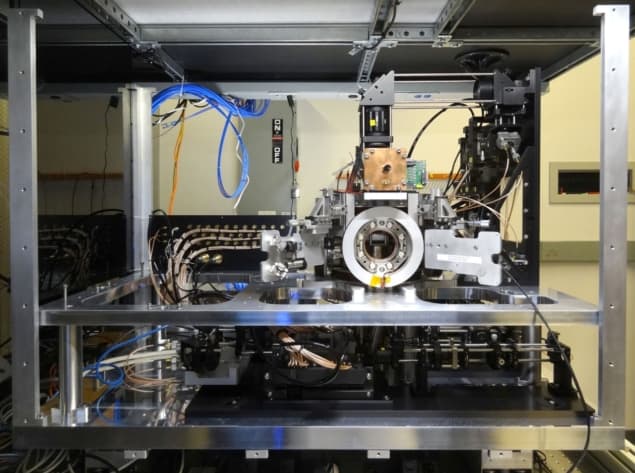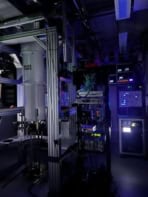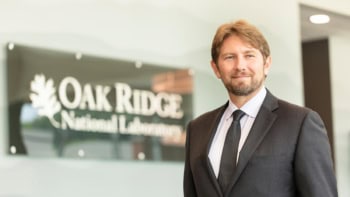
The quantum nature of qubits is a double-edged sword. While it could help quantum computers solve problems that are intractable on classical machines, it is also easily destroyed by noise arising from unintended interactions between qubits and their environment. To resolve this dilemma and create scalable, useful quantum computers, physicists are developing methods of correcting the errors that arise from this noise. Now, for the first time, researchers at the University of Maryland in the US have put one of these methods into practice by demonstrating fault-tolerant control of a single logical qubit – a key step towards fully error-corrected quantum computers.
To understand how this type of error correction works, think of the last time you corrected a typo. In doing so, you performed error correction on classical information. Because the meaning of a word is encoded in lots of letters, it doesn’t matter much if there is a mystake in one letter – you can still identify the intended word. Quantum error correction enables us to spot and correct typos in quamtum infornation in much the same way, by encoding the state of one logical qubit (the quantum word) within many physical qubits (the quantum letters). By performing specialized actions known as stabilizer measurements on these physical qubits, the system can then extract information about any errors that have occurred – crucially, without destroying the quantum information required for the computation. Based on this extracted information, the system can then apply the correct operations, or gates, to the physical qubits so that the overall state of the logical qubit is corrected, like replacing a letter to correct a word.
Error correction alone is not enough to enable scalable quantum computers, however. Spell-check would be counterproductive if it jumbled up other letters in the process of correcting one. Another essential condition for reliable quantum computers is that preparing the logical state, applying logic gates, detecting errors and correcting them must not introduce more errors into the system. In other words, these processes all need to be fault-tolerant, designed so that one error will not spread to cause more errors. This requirement is central to the task of building quantum computers that can solve useful problems.
Reduced error rates
In the latest work, which is published in Nature, researchers led by Laird Egan demonstrated the fault-tolerant control of a single logical qubit – including all the stages of preparation, logic gates and error correction. The qubits in this experiment consisted of ytterbium ions suspended above a radio-frequency Paul trap and controlled with individual laser beams. This is the hardware favoured by the quantum computing start-up IonQ, where Egan and some of his collaborators now work. The advantages of using trapped ions instead of the superconducting qubits favoured by many quantum computing firms include lower error rates and better connectivity between qubits, though there are challenges with scaling the technology.

To demonstrate fault-tolerant control, the team used a 13-qubit encoding known as the Bacon–Shor code, with nine physical qubits to encode the logical state and four qubits for error correction. These 13 qubits were arranged in a single chain, with two extra qubits on either side to ensure uniform spacing. With this system, the researchers showed that they could control the states of the logical qubits in a fault-tolerant way and correct any single-qubit errors that occurred. The team also showed that the error rates in the logical qubit were lower than the corresponding error rates when using a non-fault-tolerant protocol.
Steps towards full fault-tolerance
Egan calls the team’s achievement “a really critical building block, and one that shows we are close to achieving the error threshold where logical qubits can outperform physical qubits”. He adds: “Nobody believes that you will be able to achieve this threshold without fault-tolerant error-correction protocols, and up until this work, no one had yet demonstrated fault-tolerant control of a logical qubit.”
To pass that error threshold, the team’s next goal is to maintain an error-free quantum state over time performing error correction repeatedly. To do this will require mid-circuit error detection, where the ions in the chain are physically moved apart so that some can be measured without affecting the others. “The hard part is when we put the chain back together, we need to make sure that ions did not heat up during their transport”, explains Egan, “and if they did, we need a way to cool them back down without destroying the quantum information”. The team has made progress towards this goal by showing, in other work, that cooling such ions is possible.

New gate optimization strategy could boost efficiency in trapped-ion quantum computers
The researchers also hope to demonstrate fault-tolerant control between two qubits. To do this, they aim to implement a series of quantum operations known as a logical controlled-NOT gate, which flips the state of the second qubit conditional on the state of the first and is central to many other gates and algorithms. Egan is confident that the vision of fully fault-tolerant quantum control that outperforms physical qubits can be realized in ion traps in the near future. “Ion systems only need modest improvements to their gate fidelity, combined with mid-circuit detection, to really make this work in the next couple of years,” he says.



